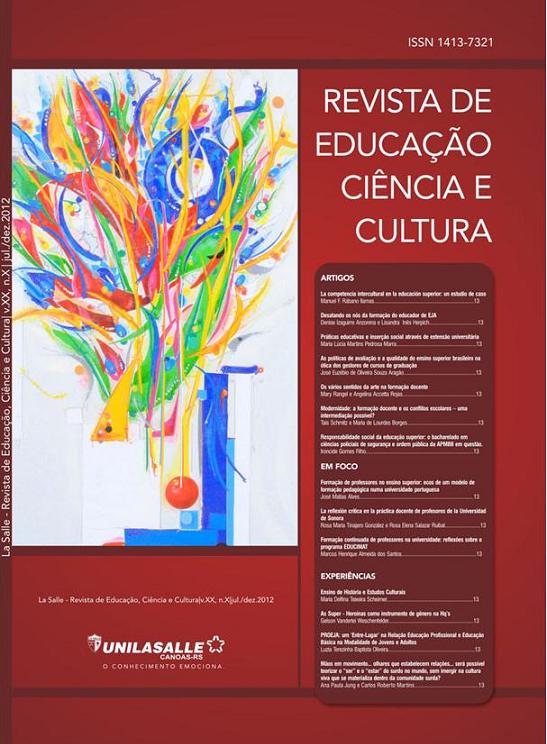Mãos em movimento... Olhares que estabelecem relações... Será possível teorizar o “ser” e o “estar” do surdo no mundo, sem imergir na cultura viva que se materializa dentro da comunidade surda?
DOI:
https://doi.org/10.18316/468Palavras-chave:
Surdez, Comunidade Surda, Cultura Surda, Identidade SurdaResumo
O artigo tem como foco central instigar a reflexão sobre o número crescente de pesquisas na área da surdez, em especial no campo da Educação, que partem de atores externos às vivências culturais dos surdos e têm provocado diferentes reações e opiniões dentro dessa comunidade. Desde a década de 80, muitos foram (e ainda são!) os movimentos em luta por reconhecimento de direitos nos quais os surdos estão engajados. Os discursos do povo surdo, em muitos momentos, têm “batido de frente” com falas ouvintistas, que costumeiramente não consideram os desejos, as ideias e os próprios conceitos que diferentes vertentes da pedagogia surda vêm consolidando. Para tanto, embasamos nossas ponderações na produção de autores como PERLIM, LOPES, THOMA e KARNOPP, referências dessa área. Ao propormo-nos “olhar de dentro”, com vias a compreender que aspectos vivenciais faltam aos pesquisadores externos à comunidade surda, muitos são os questionamentos que apontam para um descontentamento do sujeito surdo, uma vez que é e está no mundo através de uma experiência visual e extremamente vivencial, onde a realidade palpável e em movimento transcreve-se nos sinais que as mãos constroem no espaço e nas experiências onde se encontram imersos. A materialidade surda é expressa no olhar, no estabelecimento do vínculo visual entre os sujeitos, nos fatos vividos através do corpo surdo, que se encontra dentro do mundo ouvinte. Ao questionar se é possível “analisar” e ponderar sobre o surdo, decodificá-lo para então traduzi-lo, apenas “olhando” de fora sem estar no lugar do outro, desconsiderando sua complexidade e sua cultura. Com este artigo, não pretendemos apontar erros ou acertos, nem tampouco encontrar culpados ou vítimas para práticas que se tornam cada vez mais presentes nos campos de pesquisa da educação de surdos. Desejamos, pois, levar o leitor a refletir sobre as questões aqui pontuadas, buscando compreender que, em nosso entendimento, a vivência e o conhecimento vistos “de dentro” da cultura surda são fundamentais para que seja possível compreender esse sujeito cultural. Dessa forma, ao analisarmos a pouca ou nenhuma participação de um crescente número de pesquisadores ouvintes dentro da materialidade das inter-relações dos corpos surdos, numa perspectiva externa, quase que como estabelecida através de um observatório, questionamos a necessidade de uma real aproximação dos conceitos teóricos com uma verdadeira imersão cultural na comunidade surda, para, talvez, aproximar-se da compreensão de quem é esse outro, do que quer esse outro de quem falamos.
Palavras-chave: Surdez; Comunidade Surda; Cultura Surda; Identidade Surda.
Abstract: The article focuses on central instigate reflection on the growing body of research in the field of deafness, especially in the field of Education, departing from external actors to the cultural experiences of deaf and have led to different reactions and opinions within this community. Since the 80s, many were (and still are!) Movements fighting for recognition of rights in which the deaf are engaged. The speeches of deaf people, in many instances, has "hit the front" lines with listeners, who usually do not consider the desires, their own ideas and concepts that different aspects of teaching deaf has been consolidating. To this end, supports our weightings in the production of such authors as PERLIM, LOPES, Thomas and KARNOPP, references in this area. In presenting us "look inside", with ways to understand that lack the experiential aspects of the deaf community, outside researchers, there are many questions that point to a discontent deaf subject, as it is and the world is through an experience highly visual and experiential, where the palpable reality and motion signals is transcribed in the hands in space and build on experiences where they are immersed. Materiality deaf is expressed in look, in establishing the visual link between the subjects, in fact lived through the body deaf, which is within the hearing world. By questioning whether you can "analyze" and ponder the deaf, decode it and then translate it, just "looking" outside without being in the place of another, regardless of its complexity and its culture. With this article does not intend to point out mistakes or successes, nor find victims or perpetrators of practices that become increasingly present in the search fields of deaf education. We will, therefore, lead the reader to reflect on the issues punctuated here, trying to understand that, in our view, the experience and knowledge seen "inside" the deaf culture are essential to be able to understand this cultural subject. Thus, when we look at little or no participation of a growing number of hearing researchers in the interplay of the materiality of bodies deaf, from an outside perspective, almost as established by an observatory, we question the need for a real approach of theoretical concepts with a true cultural immersion in the deaf community, to perhaps get closer to understanding who is this other than this other one who wants to speak.
Keywords: Deafness, Deaf Community, Deaf Culture, Deaf identity.Downloads
Publicado
Edição
Seção
Licença
Autores que submetem seus manuscritos para serem publicados nesta revista concordam com os seguintes termos:
Autores mantém os direitos autorais e concedem à revista o direito de primeira publicação, com o trabalho simultaneamente licenciado sob a Licença Creative Commons Attribution que permite o compartilhamento do trabalho com reconhecimento da autoria e publicação inicial nesta revista.
- Em virtude dos artigos aparecerem nesta revista de acesso público, os artigos são de uso gratuito, com atribuições próprias, em aplicações educacionais e não-comerciais.
O Periódico Revista de Educação, Ciência e Cultura em http://www.revistas.unilasalle.edu.br/index.php/Educacao foi licenciada com uma Licença Creative Commons - Atribuição - Uso Não Comercial 3.0 Não Adaptada.


